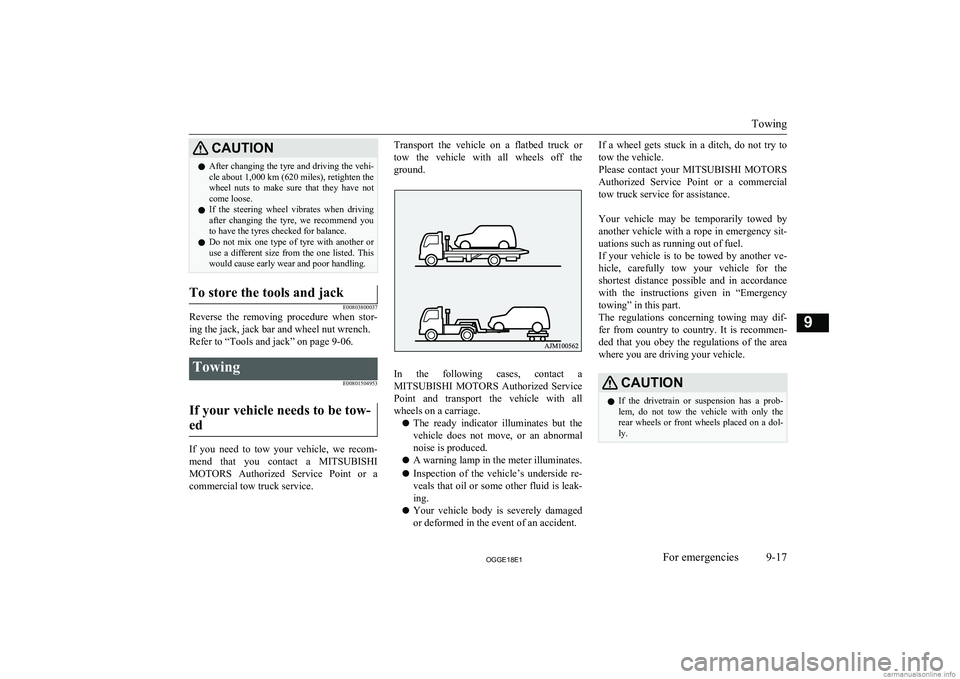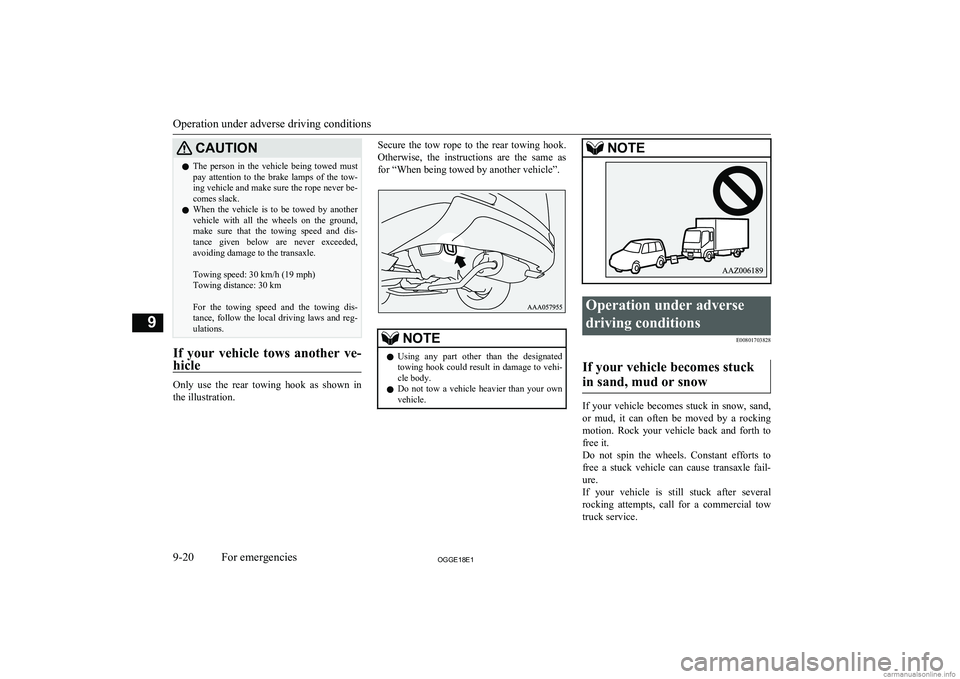Page 435 of 538

CAUTIONlAfter changing the tyre and driving the vehi-
cle about 1,000 km (620 miles), retighten the
wheel nuts to make sure that they have not come loose.
l If the steering wheel vibrates when driving
after changing the tyre, we recommend you to have the tyres checked for balance.
l Do not mix one type of tyre with another or
use a different size from the one listed. This
would cause early wear and poor handling.To store the tools and jack
E00803800037
Reverse the removing procedure when stor-
ing the jack, jack bar and wheel nut wrench.
Refer to “Tools and jack” on page 9-06.
Towing
E00801504953
If your vehicle needs to be tow-
ed
If you need to tow your vehicle, we recom- mend that you contact a MITSUBISHI
MOTORS Authorized Service Point or a
commercial tow truck service.
Transport the vehicle on a flatbed truck or
tow the vehicle with all wheels off the
ground.
In the following cases, contact a MITSUBISHI MOTORS Authorized Service
Point and transport the vehicle with all wheels on a carriage.
l The ready indicator illuminates but the
vehicle does not move, or an abnormal
noise is produced.
l A warning lamp in the meter illuminates.
l Inspection of the vehicle’s underside re-
veals that oil or some other fluid is leak- ing.
l Your vehicle body is severely damaged
or deformed in the event of an accident.
If a wheel gets stuck in a ditch, do not try to
tow the vehicle.
Please contact your MITSUBISHI MOTORS
Authorized Service Point or a commercial tow truck service for assistance.
Your vehicle may be temporarily towed by
another vehicle with a rope in emergency sit- uations such as running out of fuel.
If your vehicle is to be towed by another ve-
hicle, carefully tow your vehicle for the shortest distance possible and in accordance
with the instructions given in “Emergency
towing” in this part.
The regulations concerning towing may dif-
fer from country to country. It is recommen-
ded that you obey the regulations of the area where you are driving your vehicle.CAUTIONl If the drivetrain or suspension has a prob-
lem, do not tow the vehicle with only the
rear wheels or front wheels placed on a dol- ly.
Towing
9-17OGGE18E1For emergencies9
Page 436 of 538
Towing the vehicle by a towtruckWARNINGl Never get under your vehicle after it has
been lifted by a tow truck.
l Never ride in a vehicle that is being tow-
ed.
l Never tow the vehicle with front wheels
and/or rear wheels on the ground. This may cause damage to the electric motorsand transaxle.WARNINGCAUTIONl Never tow the vehicle using a sling type
truck.CAUTIONDoing so will damage the bumper and/or body.
Emergency towing
If your vehicle is temporarily towed by an-
other vehicle with a rope in emergency situa-
tions such as running out of fuel, the towing distance should be as short as possible and
tow carefully in accordance with the follow-
ing procedure.
Towing
9-18OGGE18E1For emergencies9
Page 437 of 538

If your vehicle is to be towed by
another vehicleWARNINGl Never tow your vehicle in this method ex-
cept in emergency situations such as run-
ning out of fuel. If the vehicle is towed in this method, a problem can occur in thevehicle damaging the motor, transaxle,
etc. indicated by illuminating warning lamps.
1. The front towing hooks are located as
shown in illustration. Secure the tow rope to the front towing hook.
NOTEl Using any part other than the designated
towing hook could result in damage to vehi-cle body.NOTEl Using a wire rope or metal chain can result
in damage to the vehicle body. It is best to use a non-metallic rope. If you use a wire
rope or metal chain, wrap it with cloth at any
point where it touches the vehicle body.
l Take care that the tow rope is kept as hori-
zontal as possible. An angled tow rope can
damage the vehicle body.
l Secure the tow rope to the same side towing
hook, to keep the tow rope as straight as pos-
sible.
2. Start the Plug-in Hybrid EV system.
If the Plug-in Hybrid EV System cannotbe started, put the operation mode of the
power switch in “ON”.
WARNINGl If the vehicle is towed with the operation
mode in “ON” without starting the Plugin
Hybrid EV System, the auxiliary battery may be fully discharged during towing. In
this case, the brake performance becomes very poor and the steering wheel becomes
very heavy.CAUTIONl For vehicle equipped with the Adaptive
Cruise Control system (ACC) and Forward Collision Mitigation system (FCM), stopthese systems to prevent an unexpected acci-
dent or unexpected operation during towing. Refer to “Adaptive Cruise Control system
(ACC)” on page 7-52 and “Forward Colli-
sion Mitigation system (FCM)” on page 7-64.
3. Put the select position in “N” (NEU-
TRAL) position.
4. Turn on the hazard warning lamps if re-
quired by law. (Follow the local driving
laws and regulations.)
5. During towing make sure that close con-
tact is maintained between the drivers of
both vehicles, and that the vehicles trav-
el at low speed.
WARNINGl Avoid sudden braking, acceleration and
steering wheel movements; such driving
operation could cause damage to the tow- ing hook or tow rope.
People in the vicinity could be injured as a
result.
l When going down a long slope, the brakes
may overheat, reducing effectiveness.
Have your vehicle transported by a tow truck.
Towing
9-19OGGE18E1For emergencies9
Page 438 of 538

CAUTIONlThe person in the vehicle being towed must
pay attention to the brake lamps of the tow- ing vehicle and make sure the rope never be-
comes slack.
l When the vehicle is to be towed by another
vehicle with all the wheels on the ground, make sure that the towing speed and dis- tance given below are never exceeded,
avoiding damage to the transaxle.
Towing speed: 30 km/h (19 mph)
Towing distance: 30 km
For the towing speed and the towing dis- tance, follow the local driving laws and reg- ulations.
If your vehicle tows another ve-
hicle
Only use the rear towing hook as shown in
the illustration.
Secure the tow rope to the rear towing hook.
Otherwise, the instructions are the same as
for “When being towed by another vehicle”.NOTEl Using any part other than the designated
towing hook could result in damage to vehi-cle body.
l Do not tow a vehicle heavier than your own
vehicle.NOTEOperation under adverse
driving conditions E00801703828
If your vehicle becomes stuck
in sand, mud or snow
If your vehicle becomes stuck in snow, sand,
or mud, it can often be moved by a rocking
motion. Rock your vehicle back and forth to
free it.
Do not spin the wheels. Constant efforts to
free a stuck vehicle can cause transaxle fail-
ure.
If your vehicle is still stuck after several rocking attempts, call for a commercial tow
truck service.
Operation under adverse driving conditions
9-20OGGE18E1For emergencies9
Page 450 of 538
BonnetE01000304487
To open
1. Pull the release lever towards you to un-
lock the bonnet.
2. Raise the bonnet while pressing the safe-
ty lock.NOTEl Only open the bonnet when the wipers are in
the original position. In any other position,the wipers could damage the paint or bonnet.3. Support the bonnet by inserting the sup-
port bar in its slot.CAUTIONl Note that the support bar may disengage the
bonnet if the open bonnet is lifted by astrong wind.
l After inserting the support bar into the slot,
make sure the bar supports the bonnet se-
curely from falling down on to your head or body.
To close
1. Unlatch the support bar and clip it in its
holder.
2. Slowly lower the bonnet to a position
about 20 cm above the closed position,
then let it drop.
Bonnet
11-04OGGE18E1Maintenance11
Page 476 of 538
2.Remove the screws (A), and then move
the lamp unit towards the rear of the ve-
hicle to unfix the notch (B) and pins (C) of the lamp unit.
3. Turn the socket anticlockwise and re-
move it, and then pull the bulb out of the
socket.
D-Rear turn-signal lampE-Tail lamp and stop lamp (LED)-cannot
be replacedNOTEl The tail lamp and stop lamp use an LED in-
stead of the bulb.
If you need to repair or replace these lamps, contact a MITSUBISHI MOTORS Author-
ized Service Point.
4. To install the bulb, perform the removal
steps in reverse.
NOTEl When installing the lamp unit, align the
notch (F) and pin (G) on the lamp unit with the clip (H) and hole (I) in the body.Licence plate lamps
E01004602325
1. Remove while pressing the lamp unit
(A) to the left side of the vehicle.
2. Insert a minus screwdriver with the end
covered with a cloth or other object to press the hook (B) aside and remove the lens.
Replacement of lamp bulbs
11-30OGGE18E1Maintenance11
Page 483 of 538
Minimum turning radiusBody5.76 mWheel5.3 m
Vehicle performanceE01100303553Maximum speed170 km/h
Vehicle weightE01100408719ItemExcept for S EditionS EditionLHDRHDLHDRHDKerb weightWithout op-tional parts1,860 kg1,880 kgWith full op- tional parts1,929 kg1,927 kg1,937 kg1,935 kgMaximum gross vehicle weight2,370 kgMaximum axle
weightFront1,160 kgRear1,255 kg, 1,365 kg *Maximum towable
weightWith brake1,500 kgWithout brake750 kgMaximum trailer-nose weight75 kg* : In case of trailer towing
Vehicle performance
12-05OGGE18E1Specifications12
Page 484 of 538
ItemExcept for S EditionS EditionLHDRHDLHDRHDMaximum roof load80 kgSeating capacity5 persons*: In case of trailer towingNOTEl Trailer specifications indicate the manufacturer’s recommendation.
Engine specifications
E01100603950Engine model4B11No. of cylinders4 in lineTotal displacement1,998 ccBore86.0 mmStroke86.0 mmCamshaftDouble overheadMixture preparationElectronic injectionMaximum output (EEC net)89 kW/4,500 rpmMaximum torque (EEC net)190 Nm/4,500 rpm
Engine specifications
12-06OGGE18E1Specifications12